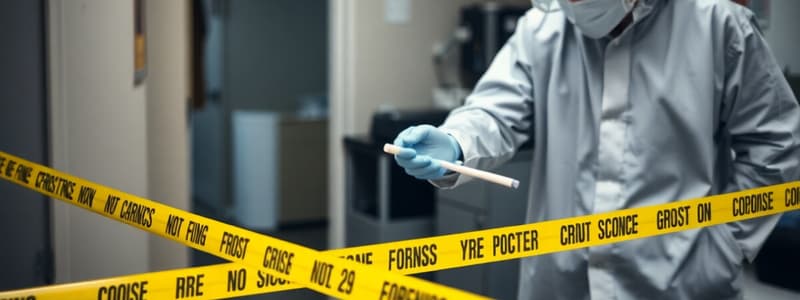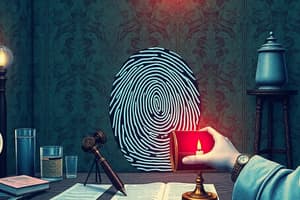Podcast
Questions and Answers
What is the primary objective of securing a crime scene during an investigation?
What is the primary objective of securing a crime scene during an investigation?
The primary objective is to control access to the scene to prevent contamination by unauthorized personnel.
Why is creating a sketch of the crime scene important?
Why is creating a sketch of the crime scene important?
Creating a sketch provides a diagrammatic representation of the scene, including measurements and the location of evidence.
What is the significance of maintaining a detailed chain of custody in forensic investigations?
What is the significance of maintaining a detailed chain of custody in forensic investigations?
It ensures the reliability of evidence and shows that it has not been tampered with, which is crucial for admissibility in court.
How does bloodstain pattern analysis assist in crime scene reconstruction?
How does bloodstain pattern analysis assist in crime scene reconstruction?
Describe the significance of conducting a preliminary survey in a crime scene investigation.
Describe the significance of conducting a preliminary survey in a crime scene investigation.
List two methods for appropriately packaging evidence to maintain its integrity.
List two methods for appropriately packaging evidence to maintain its integrity.
What practices are essential for collecting and packaging evidence at a crime scene?
What practices are essential for collecting and packaging evidence at a crime scene?
How does systematic searching for evidence benefit a crime scene investigation?
How does systematic searching for evidence benefit a crime scene investigation?
In what way does trace evidence contribute to linking suspects or victims to a crime scene?
In what way does trace evidence contribute to linking suspects or victims to a crime scene?
What role does expert testimony play in court concerning forensic science findings?
What role does expert testimony play in court concerning forensic science findings?
What role does photographic documentation play in a crime scene investigation?
What role does photographic documentation play in a crime scene investigation?
Why is continuous learning important for professionals in forensic science?
Why is continuous learning important for professionals in forensic science?
Why is it important to maintain the integrity of a crime scene during an investigation?
Why is it important to maintain the integrity of a crime scene during an investigation?
What types of physical evidence should investigators be searching for at a crime scene?
What types of physical evidence should investigators be searching for at a crime scene?
Describe one reason why document examination is significant in forensic investigations.
Describe one reason why document examination is significant in forensic investigations.
What factors are considered in crime scene reconstruction to understand the events that occurred?
What factors are considered in crime scene reconstruction to understand the events that occurred?
What is the primary distinction between the manner of death and the cause of death?
What is the primary distinction between the manner of death and the cause of death?
List and briefly describe the five common manners of death.
List and briefly describe the five common manners of death.
Explain how a medical examiner determines the cause of death.
Explain how a medical examiner determines the cause of death.
Provide an example of a situation that would be classified as a homicide.
Provide an example of a situation that would be classified as a homicide.
Why is the determination of the manner and cause of death important in legal proceedings?
Why is the determination of the manner and cause of death important in legal proceedings?
What might lead to a classification of 'undetermined' as the manner of death?
What might lead to a classification of 'undetermined' as the manner of death?
What is meant by 'accidental death' and provide an example?
What is meant by 'accidental death' and provide an example?
Differentiate between a natural death and a suicidal death based on examples.
Differentiate between a natural death and a suicidal death based on examples.
Flashcards
Forensic Science Definition
Forensic Science Definition
Applying scientific methods to legal issues, collecting, analyzing, & interpreting evidence.
Crime Scene Investigation
Crime Scene Investigation
Carefully examining a crime scene to collect & preserve evidence.
Securing the Crime Scene
Securing the Crime Scene
Controlling access to prevent contamination by unauthorized people.
Preliminary Crime Scene Survey
Preliminary Crime Scene Survey
Signup and view all the flashcards
Crime Scene Photography
Crime Scene Photography
Signup and view all the flashcards
Crime Scene Sketching
Crime Scene Sketching
Signup and view all the flashcards
Evidence Collection Procedure
Evidence Collection Procedure
Signup and view all the flashcards
Importance of Evidence Preservation
Importance of Evidence Preservation
Signup and view all the flashcards
Chain of Custody
Chain of Custody
Signup and view all the flashcards
Evidence Packaging
Evidence Packaging
Signup and view all the flashcards
Trace Evidence
Trace Evidence
Signup and view all the flashcards
Crime Scene Reconstruction
Crime Scene Reconstruction
Signup and view all the flashcards
DNA Evidence
DNA Evidence
Signup and view all the flashcards
Expert Testimony
Expert Testimony
Signup and view all the flashcards
Forensic Science
Forensic Science
Signup and view all the flashcards
Bloodstain Pattern Analysis
Bloodstain Pattern Analysis
Signup and view all the flashcards
Manner of Death
Manner of Death
Signup and view all the flashcards
Cause of Death
Cause of Death
Signup and view all the flashcards
Natural Death
Natural Death
Signup and view all the flashcards
Accidental Death
Accidental Death
Signup and view all the flashcards
Suicide
Suicide
Signup and view all the flashcards
Homicide
Homicide
Signup and view all the flashcards
Undetermined Death
Undetermined Death
Signup and view all the flashcards
What's the difference between manner and cause of death?
What's the difference between manner and cause of death?
Signup and view all the flashcards
Study Notes
Introduction to Forensic Science
- Forensic science is the application of scientific methods and principles to legal matters. It involves the collection, analysis, and interpretation of evidence to assist in solving crimes or civil disputes.
- Forensic science draws on many disciplines (e.g., biology, chemistry, physics, computer science) to address legal issues.
- This interdisciplinary approach ensures a thorough investigation.
- The goal is to provide objective and reliable information for legal proceedings.
- Forensic scientists work with law enforcement, legal professionals, and other experts.
Crime Scene Investigation Basics
- Crime scene investigation (CSI) is a crucial part of forensic science.
- It involves the careful examination of the scene where a crime occurred.
- The objective is to collect and preserve evidence for later analysis.
- Early actions at a crime scene are critical.
- Establishing a secure perimeter is paramount.
- Maintaining the integrity of the scene is essential for preventing contamination or alteration of evidence.
- Identification of potential evidence is a key step when documenting the crime scene.
- Appropriate protective measures during scene investigation are critical for minimizing contamination, handling equipment, and proper evidence collection.
Key Aspects of Crime Scene Investigation
- Securing the scene: Controlling access to the crime scene is the first and most crucial step. This prevents contamination by unauthorized personnel.
- Preliminary survey: Observation of the overall scene, noting the location and nature of evidence. A visual documentation of the crime scene, capturing detailed images and videos.
- Photographing the scene: Documentation is comprehensive, including close-up shots of objects and evidence, and overall views.
- Sketching the scene: Creating a diagrammatic representation of the crime scene which includes measurements and location of evidence.
- Searching for evidence: Systematically searching all areas of the crime scene for physical evidence (e.g., fingerprints, DNA, fibers, trace evidence, etc.).
- Collecting evidence: Collecting and packaging evidence carefully is necessary for maintenance of integrity of the item. Correct chain of custody procedures are followed. It's done using appropriate containers to prevent contamination.
- Recording and preserving: Maintaining an accurate record of all steps during the investigation and packaging evidence correctly, while also maintaining a detailed chain of custody.
- Evidence packaging: Evidence must be appropriately packaged to maintain its integrity and avoid contamination. Examples include sealed envelopes, paper bags, or evidence containers. The proper chain of custody must meticulously be maintained.
Types of Evidence
- Trace evidence (hair, fibers, paint) can link suspects/victims to the scene.
- Bloodstain pattern analysis helps understand the sequence of events.
- DNA evidence provides highly specific genetic information from biological samples.
- Fingerprint analysis is used to identify individuals.
- Document examination involves analysis of signature and handwriting, as well as altered documents.
- Ballistics, firearm analysis, and tool marks are used to connect weapons and tools to a crime.
Importance of Chain of Custody
- The chain of custody is the documented and unbroken record of how an item was handled and moved from the time it was collected at the crime scene until it is presented in court.
- This is crucial to maintain evidence reliability.
- All personnel involved in handling the evidence must be recorded on the chain of custody record.
- It shows potential tampering has not occurred and is an assurance to the court that the item is authentic.
- Records must be thorough for admissibility in court proceedings.
Crime Scene Reconstruction
- Reconstruction of the scene aims to understand the events leading to the crime scene.
- Evidence analysis and witness testimony are used in this process to outline possible events.
- This process may reveal the sequence of events, the position of individuals, and the likely cause and manner of death (if applicable).
- Using that information helps solve crimes more effectively and accurately.
Other Key Concepts in Forensic Science
- Expert Testimony: Presenting forensic findings to court requires effective communication and adherence to legal guidelines.
- Continuous Learning: Forensic science is a continuously evolving field, with new techniques and technologies emerging constantly. Staying up-to-date with advances is important.
- Ethics: Forensic science professionals must adhere to strict ethical standards to ensure objectivity and integrity.
Studying That Suits You
Use AI to generate personalized quizzes and flashcards to suit your learning preferences.



